We may receive a commission when you use our affiliate links. However, this does not impact our recommendations.
One of the gripes I hear about French workbenches is that the benchtops are difficult to flatten because of the end grain protruding through the top.
I don’t buy it. Here are a few simple tricks that deflate that argument.
1. Start with ‘Stop Shavings’
When I flatten a French benchtop, the first thing I do (after sharpening the iron of my jointer plane) is to plane down the end-grain areas of the benchtop. I make short “stop shavings” over the legs until the handplane stops cutting.
These stop shavings effectively take the end grain out of the equation during your long-grain strokes along the benchtop. After a few full-length passes, I return to the end-grain areas and knock them down a little more.
Removing the end grain first makes the full-length passes easier.
Oh, and I also use stop shavings over knots or any other patches of rough grain.
2. Use Alcohol or Mineral Spirits
The benchtop shown here is cherry; the legs are cottonwood, which is pretty easy to plane. When I flatten a bench in maple or oak, I’ll moisten the end grain with alcohol or mineral spirits to soften it up.
3. Keep your Paraffin Close and Hot
When I flatten a benchtop, it helps to wax the sole after every complete pass over the benchtop. To make that process easier, I keep the paraffin in my left hand (which grasps the knob of the plane).
This does two things:
A. It keeps the paraffin close so I don’t have to waste time looking for it under the shavings.
B. Because paraffin starts to melt at 99° (F), it softens in my hand and makes it easier to apply a wide swath of wax in one stroke. If you are a woodworker in the Deep South you already know this – paraffin blocks turn to puddles in the summer.
4. Pick Your Battles
As with any benchtop, it doesn’t need to be as flat as a granite surface plate – just flat enough to work. Don’t worry about minor low spots along the back edges or in other areas that you don’t use much.
Get it flat(tish) and get back to building furniture.
— Christopher Schwarz
Here are some supplies and tools we find essential in our everyday work around the shop. We may receive a commission from sales referred by our links; however, we have carefully selected these products for their usefulness and quality.













I’ve read your first book on workbench construction (several times) and have successfully made my first French style bench (albeit my own tweaks on the designs you provided). Flattening the bench top went well using the techniques you suggested. Now I’m building a white oak dining room table. I know flattening the top will follow the same principles as for a bench top. My only question / concern is with a 42″ wide top that’s 72″ long, how do I reach across the entire top with my planes? Reaching across my 26″ bench top was stretching the limits of my reach for the diagonal passes.
Jeff
Still don’t get the (undeniably visually appealing) swing back to legs through the top on benches Chris. 🙂
As well as creating the requirement to plane end grain they can’t anyway stay flush due to seasonal variation in the bench top thickness. There’s also the old issue of the top pushing the legs out of vertical as the width of the top changes.
Neither is a show stopper, but it’s surely another of these design features that as a result of repetition in recent years risks becoming a convention that’s strictly speaking more about show than function???
The one advantage i can figure is that it (depending on the layout and type) may ease vise placement by eliminating the need for a space occupying cross piece linking the legs under the top…
Makes sense, thanks.
To keep from showing my ignorance I Googled “stop shavings” . I should have known better.
So what is “stop shavings”?
Stop shavings. That’s a damn good idea and I can use that. Thanks!